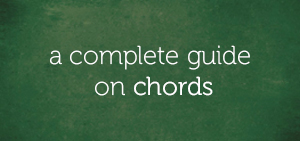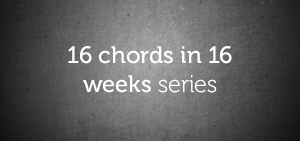In this lesson, we’ll be focusing on the application of common chord progressions in gospel music.
Gospel music harmony is rich with a variety of chord progressions. Congregational songs, hymns, worship transitions, fancy endings to songs, talk music etc., are all full of chord progressions.
However, we’re highlighting seven of them and breaking down how they can be applied.
Check them out!
#1 – Application Of The Classic 2-5-1 Chord Progression
The 2-5-1 chord progression is commonly used at the end of songs. In the song Thank you Lord, the 2-5-1 chord progression can be applied at the end of the song thus:
I just want to (chord 2):
…thank You (chord 5):
…Lord (chord 1):
The last three chords in most gospel songs are likely to be the chords of the 2-5-1 chord progression.
#2 – Application Of The Popular 1-5-6-4 Chord Progression
The 1-5-6-4 chord progression is quite popular among gospel musicians.
The song He’s Able is composed to conform to the 1-5-6-4 chord progression and is played thus in the key of C major:
God is able to (chord 1):
Do just what he (chord 5):
…says he will (chord 6):
…do (chord 4):
#3 – Application Of The 1-4 Chord Progression
The 1-4 chord progression is used a lot in gospel music and has lots of varieties. But what we covered in this lesson can be used to play songs like Oh Happy Day.
Kindly check it out:
Oh happy (chord 1):
…day (chord 4):
The 1-4 chord progression can be applied over other songs like I will bless the Lord at all times and My redeemer lives.
“Check Out My Redeemer Lives…”
I know (chord 1):
…he rescued my soul (chord 4):
His blood has (chord 1):
…covered my sins (chord 4):
“Check Out I Will Bless The Lord At All Times…”
I will bless the Lord at (chord 1):
…all times he’s (chord 4):
…good (chord 1):
Passing chord (chord 4):
#4 – Application Of The 1-b7-4 Chord Progression
Adding a b7 chord to the 1-4 chord progression produces the 1-b7-4 chord progression and it’s used in gospel music as a worship transition.
Each of the chords can be played using the following counts:
Chord 1 (4 counts):
Chord b7 (4 counts):
Chord 4 (4 counts):
…or:
Chord 1 (4 counts):
Chord b7 (2 counts):
Chord 4 (2 counts):
…and so on.
#5 – Application Of The 1-2-4 Chord Progression
Adding a 2 chord to the 1-4 chord progression produces the 1-2-4 chord progression and it’s also used in gospel music as a worship transition.
Each of the chords can be played using the following counts:
Chord 1 (4 counts):
Chord 2 (4 counts):
Chord 4 (4 counts):
…or:
Chord 1 (4 counts):
Chord 2 (2 counts):
Chord 4 (2 counts):
…and so on.
#6 – Application Of The 4-5-6 Chord Progression
The 4-5-6 chord progression is one of the top progressions used in contemporary gospel music. From Make me Over by Tonex to I need You Now by Smokie Norful
“Check Out I Need You Now…”
Not a second or a(chord 4):
…nother (chord 5):
…minute, Not an(chord 6):
…hour or a (chord 4):
…nother (chord 5):
…day (chord 6):
“Check Out Make Me Over Again…”
Make me (chord 4):
…over a (chord 5):
…gain (chord 6):
The 4-5-6 chord progression can also be used as a worship progression or in talk music by observing the counts accordingly:
Chord 4 (2 counts):
Chord 5 (2 counts):
Chord 6 (4 counts):
#7 – Application Of The 4-5-b6-b7-1 Chord Progression
The 4-5-b6-b7-1 chord progression can be used to give a song a fancy ending. Consequently, it is used to substitute chord 1 at the end of a song.
In the key of C major:
…where chord 1 is the C major triad:
…The C major triad can be substituted with the 4-5-b6-b7-1 chord progression.
“In The Song Thank You Lord…”
Thank you Lord should end on:
Lord (chord 1):
Chord 1 in this case is substituted with the 4-5-b6-b7-1 chord progression:
Lord (chord 4):
Chord 5:
Chord b6:
Chord b7:
Chord 1:
Attention: Chord 1 came at the end of the 4-5-b6-b7-1 progression, however, the 4 chords that came earlier created more anticipation for it and that’s the idea.
Final Words
From what we just learned, I have no doubt that you’ve seen how common chord progressions can be applied in gospel music.
See you in the next lesson!
Chuku Onyemachi
Latest posts by Chuku Onyemachi (see all)
- The Formation Of Diminished Seventh Chords Used To Be Challenging Until I Did This
- How To Form Seventh Chords In Two Shakes Of A Dog’s Tail Using Third Intervals And The Circle Of Fifths Chart
- I Played The 13sus4 Chord And This Happened…
- How To Build Seventh Chords Like An Architect Using “Foundation And Structure” Concept
- This 4-Week Plan Will Help You Master All The Major Scales







Comments on this entry are closed.